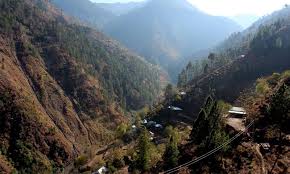The picturesque forests of Diamer-Chilas, nestled within the majestic Himalayan landscape of Gilgit-Baltistan, are facing an environmental crisis. Rapid deforestation in the region, driven by illegal logging and expanding agriculture, is not only threatening local ecosystems but is also contributing to broader climate change impacts in Pakistan.
Once a critical carbon sink, the forests of Diamer-Chilas are being cleared at an alarming rate, jeopardizing the region’s ability to mitigate the effects of climate change. The removal of trees has far-reaching consequences for local weather patterns, biodiversity, and the livelihoods of communities who rely on forest resources.
Gilgit-Baltistan, renowned for its pristine natural beauty and rich biodiversity, has long relied on its forests to provide a buffer against environmental challenges. However, in Diamer-Chilas, unsustainable practices are threatening the region’s forest cover. Increasing demand for timber, used in construction and fuelwood, is leading to large-scale tree felling, often illegally. This, coupled with land cleared for agriculture, is contributing to forest loss on a significant scale.
The effects are being felt locally and beyond. “We are seeing the climate changing faster than we imagined,” said one local resident in Chilas. “The summers are hotter, and the winters are no longer as cold as they used to be. This is not just nature; it’s because the forests are vanishing.”
Forests are crucial in the fight against climate change, as they absorb carbon dioxide (CO2) from the atmosphere. In the case of Diamer-Chilas, deforestation is releasing vast amounts of stored carbon, exacerbating global warming and contributing to erratic weather patterns. The once stable, forested slopes of the region are also now prone to landslides and soil erosion, particularly during the monsoon season.
Gilgit-Baltistan is already highly vulnerable to climate change, and deforestation only increases the region’s susceptibility to extreme weather events, such as floods and droughts. With more frequent glacial melt and reduced forest cover, the risk of glacial lake outburst floods (GLOFs) is growing, putting communities in the valleys of Diamer-Chilas in grave danger.
For the people of Diamer-Chilas, the consequences of deforestation are both economic and environmental. Forests provide timber, firewood, and fodder, while also serving as a natural defense against the harsh climate. As these forests disappear, local communities are increasingly exposed to natural disasters like landslides and floods, which can destroy homes, infrastructure, and farmland.
“We have lost some of our best grazing land and fruit-bearing trees,” says a local farmer. “The forest used to protect us from floods, but now we live in fear during the rainy season.”
In addition to the risks posed to human life, deforestation in the region is contributing to habitat loss for wildlife. Endangered species, such as the Himalayan ibex and snow leopard, rely on these forests for survival. The shrinking habitat threatens their populations and the overall biodiversity of the region.
Recognizing the importance of Gilgit-Baltistan’s forests, the Pakistani government has initiated reforestation campaigns, including the Ten Billion Tree Tsunami program.
Experts emphasize the need for community-based forest management as a way forward. By involving local communities in conservation efforts and offering alternative sources of income—such as eco-tourism or sustainable forestry practices—the government could foster greater support for preserving forests.
“Local people are key to solving this issue,” says an environmental expert in Gilgit-Baltistan. “If they are empowered to manage the forests sustainably, both the environment and the people can benefit.”
Additionally, greater enforcement of laws against illegal logging and deforestation is crucial. Strengthening forest management and providing alternative energy sources, such as solar power, can reduce reliance on wood for fuel, slowing the rate of forest depletion.
The deforestation crisis in Diamer-Chilas is a growing threat not only to Gilgit-Baltistan but to Pakistan’s broader fight against climate change. The loss of forests is directly contributing to increased climate vulnerability, more frequent natural disasters, and the erosion of local livelihoods. Without urgent and sustainable solutions, the damage could become irreversible.
As the impacts of climate change intensify across the region, preserving the forests of Diamer-Chilas has become a critical priority for both the government and the local communities. With coordinated action and long-term planning, there is still hope to restore these forests and secure a sustainable future for the people of Gilgit-Baltistan.


